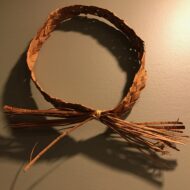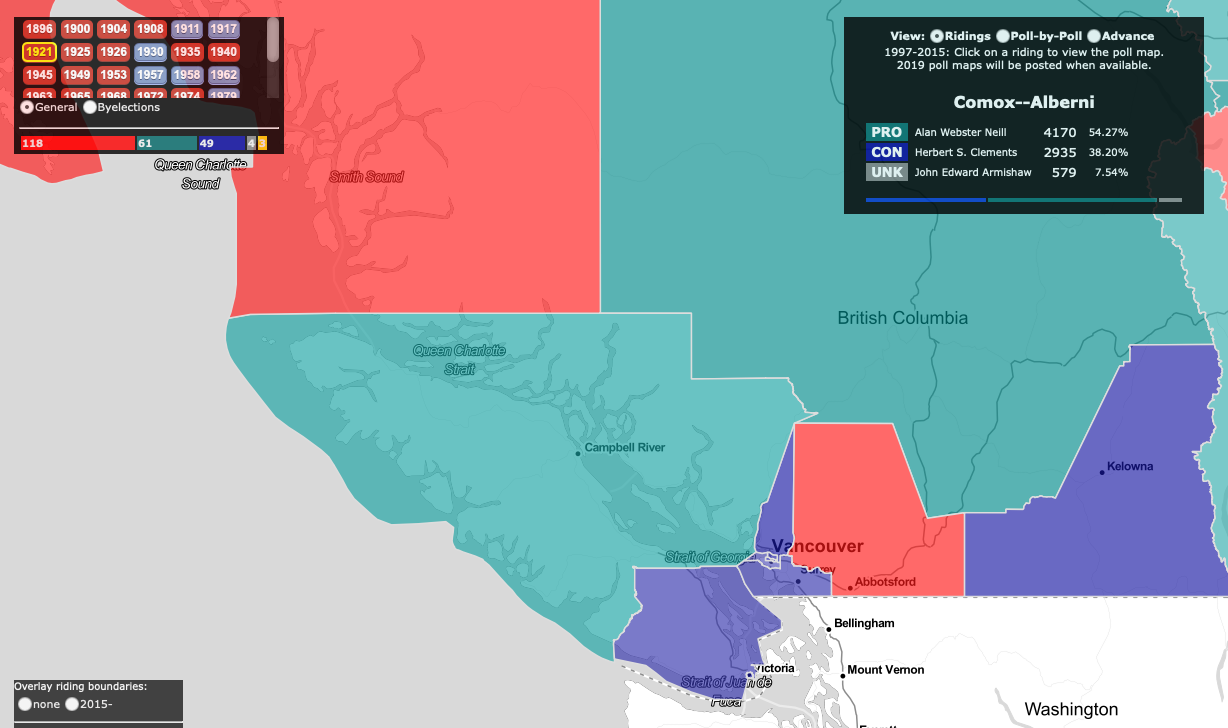Wow, that’s a lot of data.
On January 30, I stumbled across an amazing and new resource called election-atlas.ca. It has compiled, through maps, the results of every Canadian federal and provincial election since Canada was a country! Amazing!
In this blog you will find a story of the riding that has included Port Alberni for the past 124 years.

Click the image to go to the website.
Pre WWI: A few people representing most of Western B.C.
Naturally, I just had to dig into all the ridiculous data!
Just watching the ridings change through the past 120 years as I click on each election button was fascinating. Did you know that in 1896, Port Alberni (and all of Vancouver Island outside of Victoria) was part of a riding called Vancouver? Me Neither!
Fun fact, the City of Vancouver wasn’t even part of the riding!
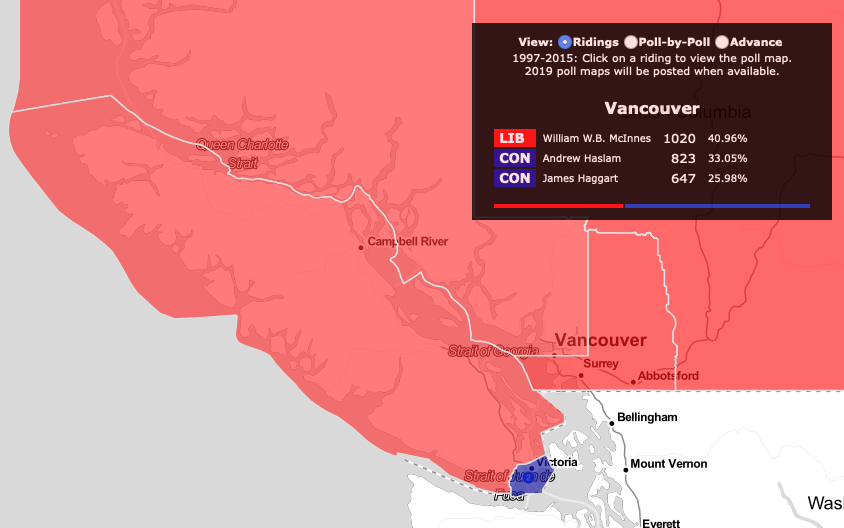
It stayed that way until the 1904 election when a new Nanaimo riding was created that encompassed most of the South Island including the Saanich Peninsula, except the city of Victoria.
Port Alberni became part of the Comox-Atlin riding which included half of the rest of British Columbia!
William Sloan won that election as well as the next in 1908 by acclamation. The only time Port Alberni’s riding has been uncontested. (He first ran in 1900)
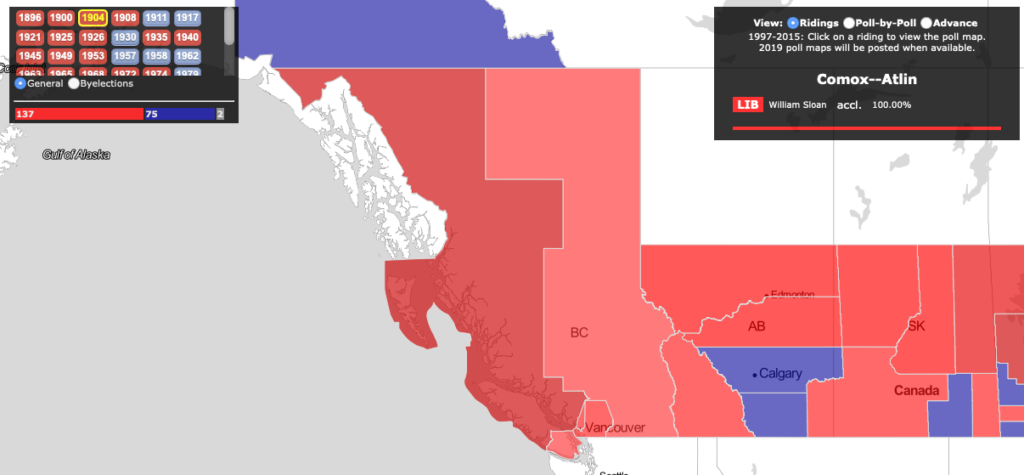
Things got a little more interesting in 1911 when Herbert Clements and Duncan Ross split the vote pretty evenly, the Conservative won (as part of the first Tory government).
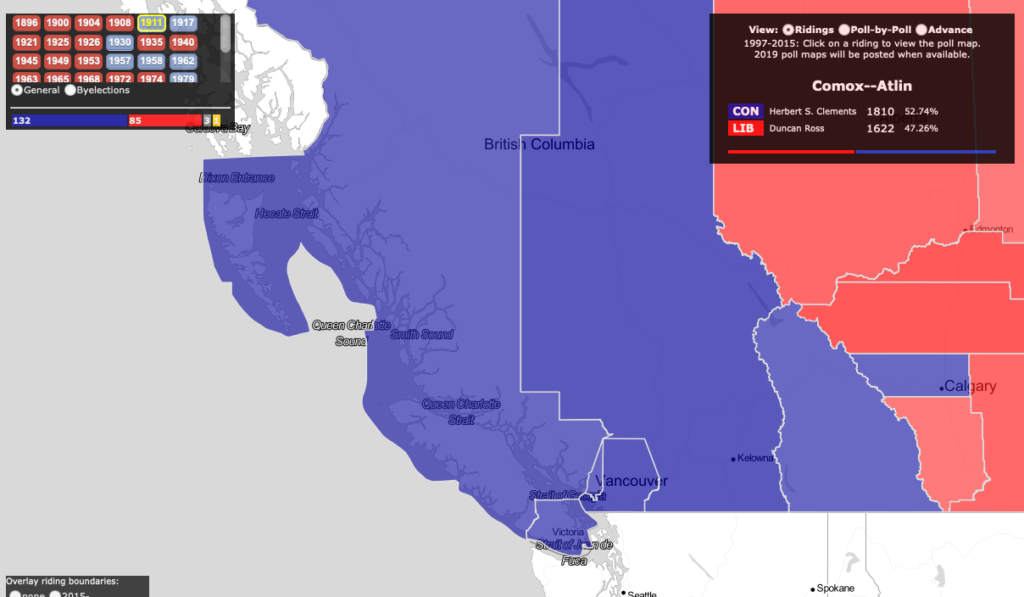
Alberni on the Map
The First World War brought a lot of change and huge growth.
Just under 4000 people voted in the entire Comox-Atlin riding in 1911. The 1917 election was the first to feature the name Alberni as the Comox-Atlin riding was split in two into the Skeena and Comox-Alberni ridings as the populations of both skyrocketed.
More than 18,000 and 5000 people voted in Skeena, and Comox-Alberni respectively.
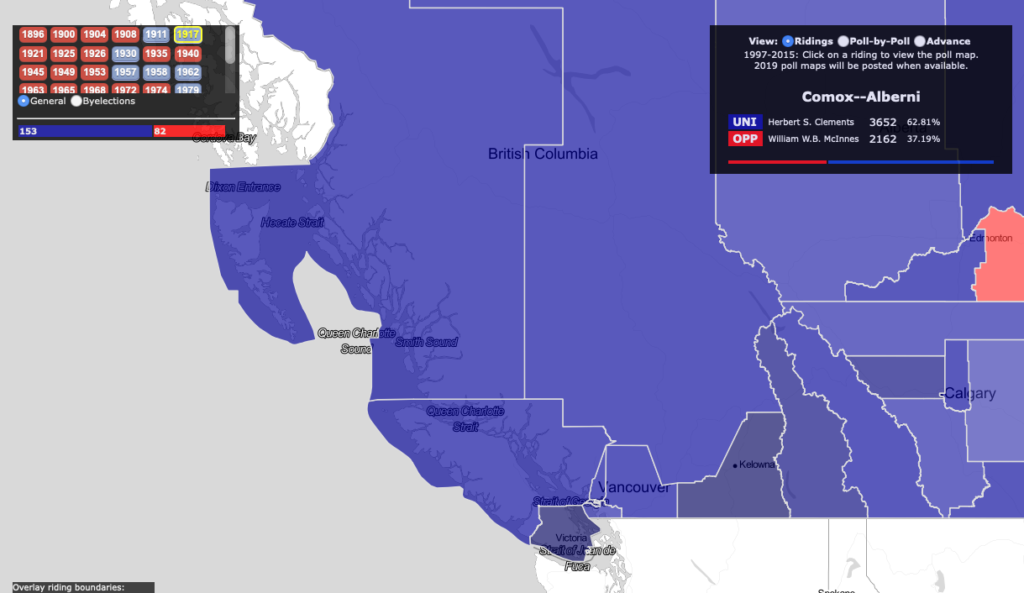
Independant Dynasty
In 1921 there was upheaval in Federal political parties and the House fractured. The Liberal party did not run a candidate in Comox-Alberni, instead Alan Webster Neill, who had run unsuccessfully as an Independent in the Provincial election in 1916, ran as a Federal Progressive candidate and beat Clements and John Armishaw who would run in 1926 elections as the first Labour candidate in the riding.
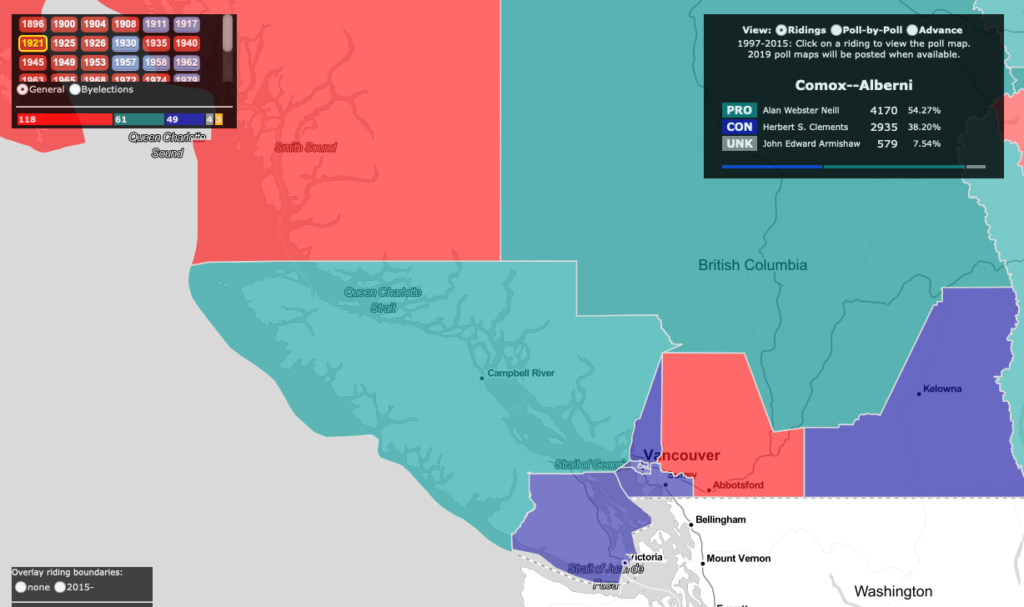
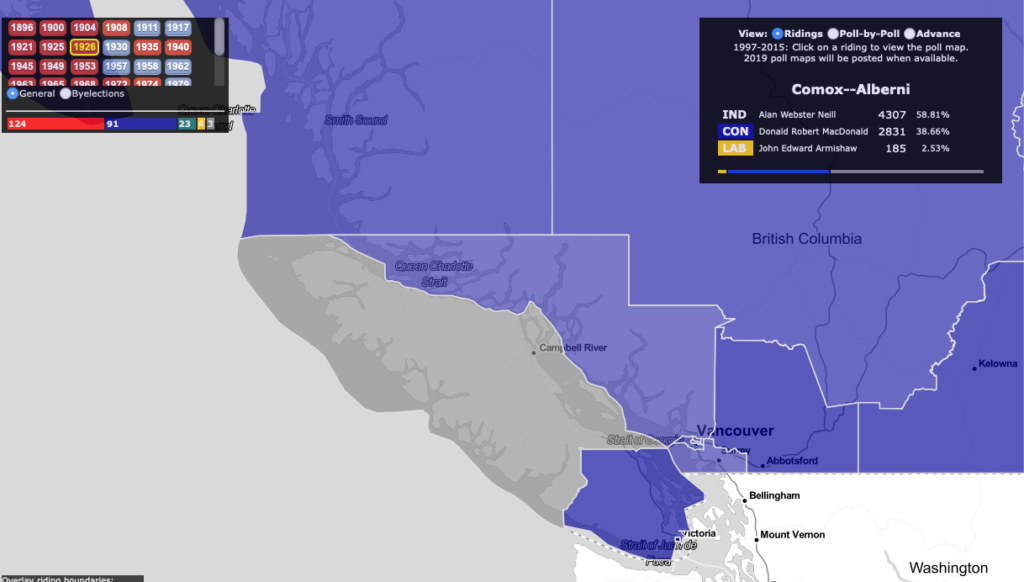
It is interesting to note that through the 1920s the surrounding ridings featured exclusively one Liberal and one Conservative contesting the elections up to 1930. Comox-Alberni sometimes had a third candidate but did not feature a Liberal candidate again until the 1953 election after both Neill and his successor John Gibson retired.
A new party, in for the long haul.
The 1935 election was definitely the most interesting of the pre-war elections in Port Alberni as it featured five candidates. Neill, an Independent since his first election, was up against the brand new CCF (pre-NDP), Conservatives, Labour and Reconstruction parties.
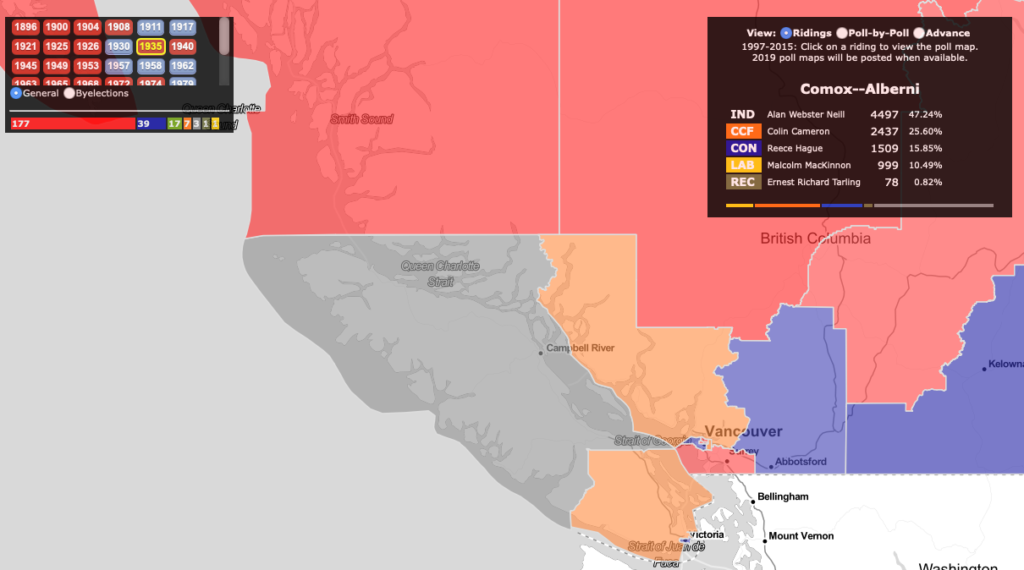
However, as WWII began in 1939, the 1940 election saw a huge retrenchment. Only the CCF contested the aging Neill as both the Liberal and Conservative parties stepped away.

Independence one last time.
With WWII coming to a close and Neill retired, the 1945 election saw the riding feature all new faces, but still continued its tradition of electing independent politicians, this time the “Independent Liberal” John Gibson beating Thomas Barnett of the CCF and a 3rd candidate.
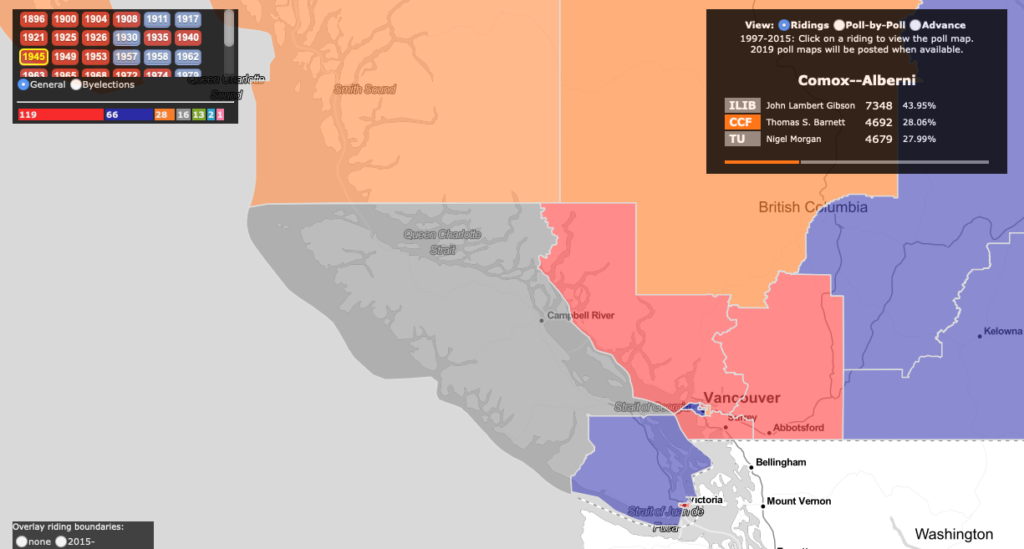
Gibson won again in 1949 over the CCF though it was one of the closest elections since before the war with just two candidates splitting a large number of voters each. This is the only time a “losing” candidate garnered over 40% of the vote in the Comox-Alberni riding since it was created in 1917.

Democratic Awakening
1953 was a watershed moment for the riding as it was the first time since before WWI that both the Conservative (now split into Progressive Conservative and Social Credit parties) and Liberal parties ran candidates.
The result?
The CCF took the riding for the first time with Thomas Barnett winning on his second try.
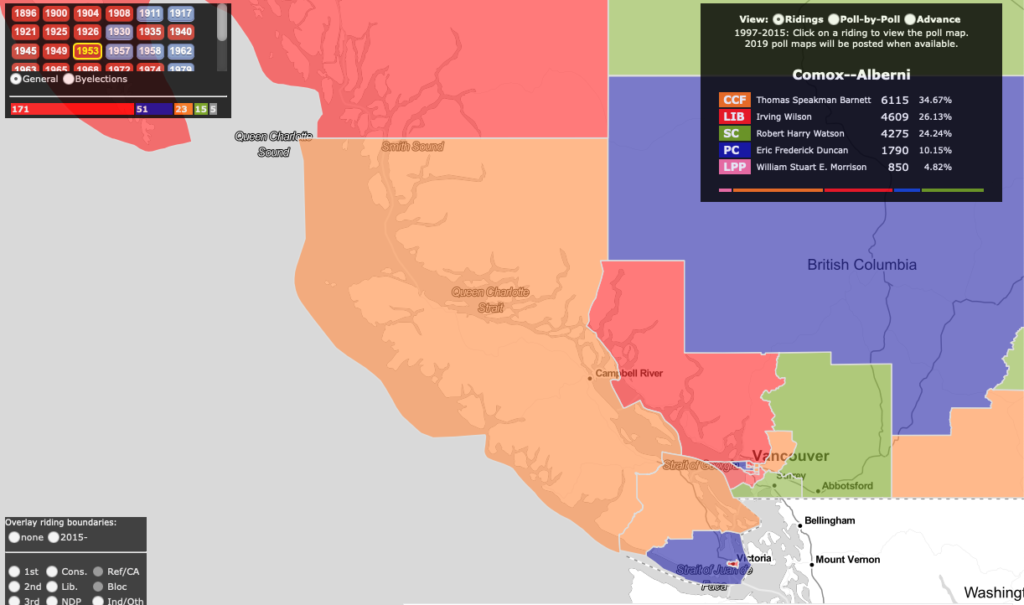
It is also worth noting that the riding expanded slightly northward to include parts of the Central Coast.
Barnett held on to the riding in 1957 with Henry Mcquillan of the Progressive Conservatives giving him a good run for his money and the Social Credit party no doubt playing spoiler for both the PC and Liberal parties as they took much of the rural Lower Mainland.
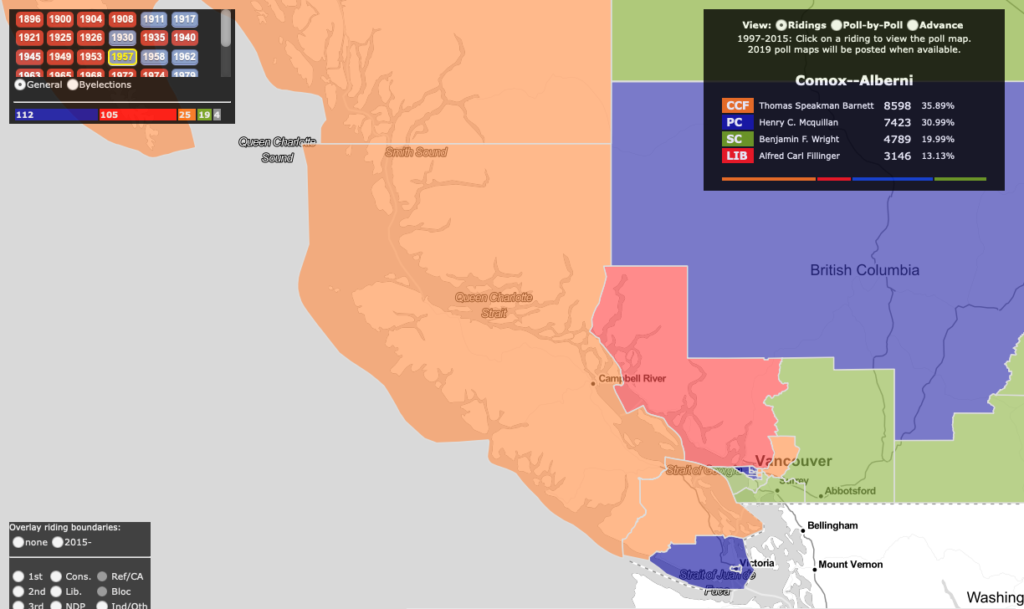
1958 came quickly though and McQuillan took the riding easily over the CCF for the first win by a Conservative candidate since Clements 41 years earlier.
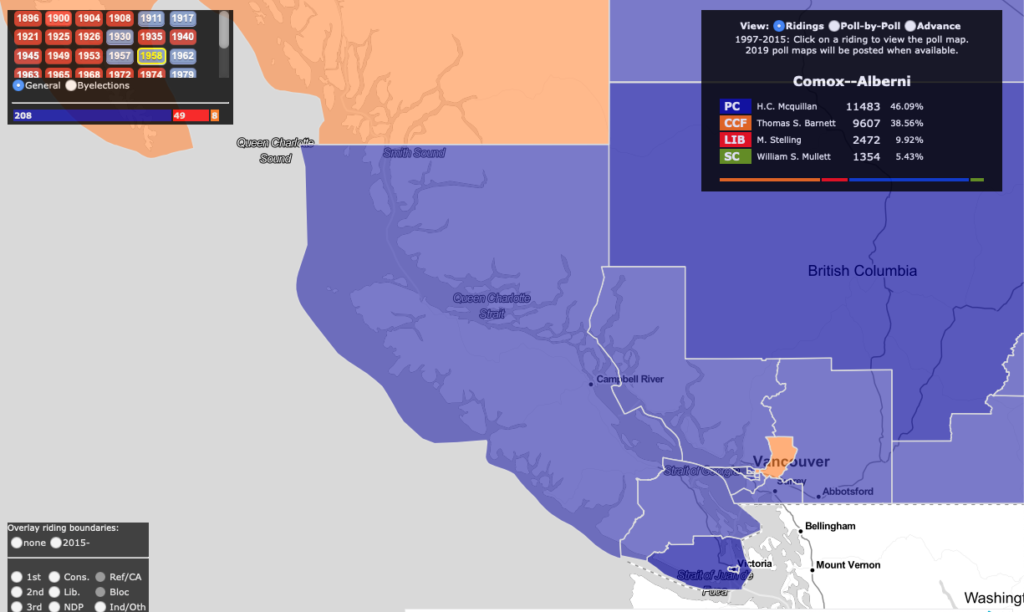
The Conservative victory was short-lived though as the NDP evolved from the CCF and Barnett took back the riding easily with the Liberals beating out McQuillan’s Conservatives for 2nd.
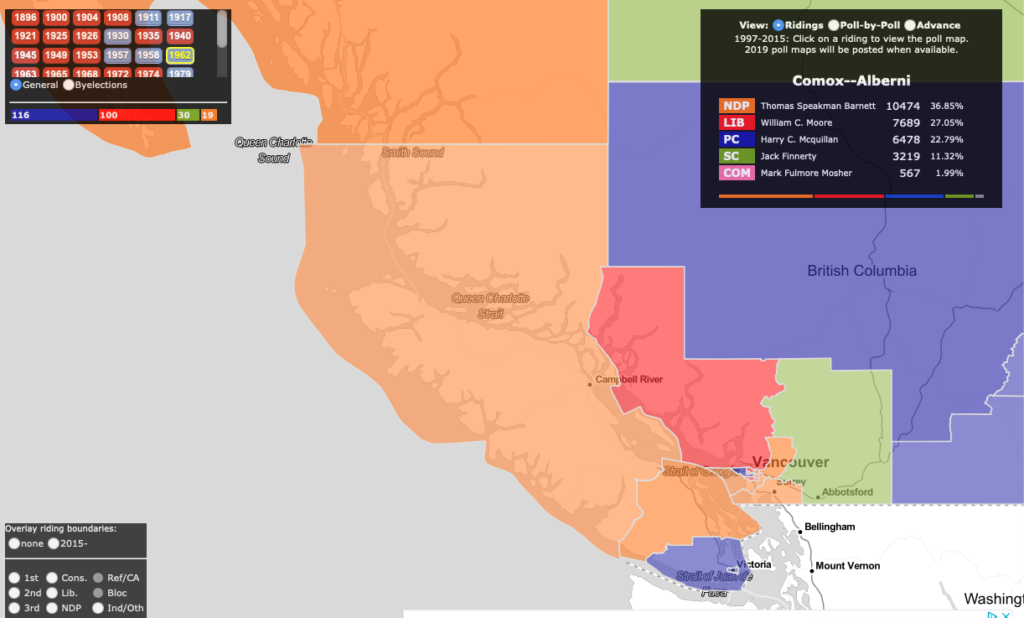
By a Hair
Barnett held the riding through the tumultuous elections of the 1960s until finally losing it in the closest election in the riding’s history in 1968.
The riding was now limited to only Vancouver Island and the northern Gulf Islands.
The margin of victory for Richard Durante of the Liberal Party over Barnett of the NDP was just 9 votes.
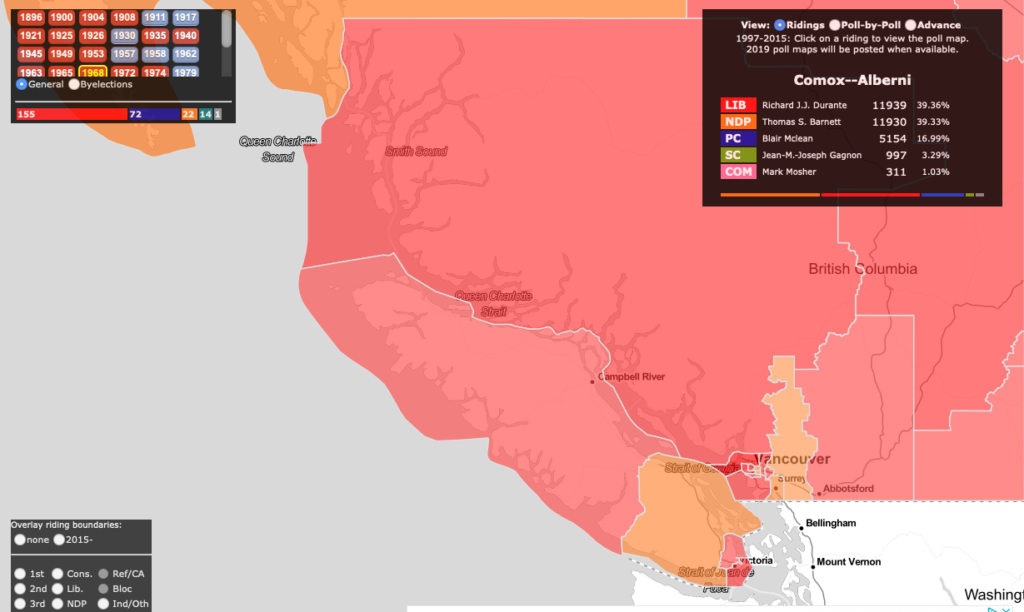
Barnett wasn’t deterred though as he easily won the riding, as did many NDP candidates in the province, with Tommy Douglas running next door in Nanaimo-Cowichan-TheIslands in the following election in 1972.

Barnett retired before the 1974 election and in his absence Hugh Anderson of the Liberal party won a narrow victory over the PC and NDP party. The 1974 election was also the only election in Comox-Alberni that featured a Communist Party candidate getting more than 1% of the vote.
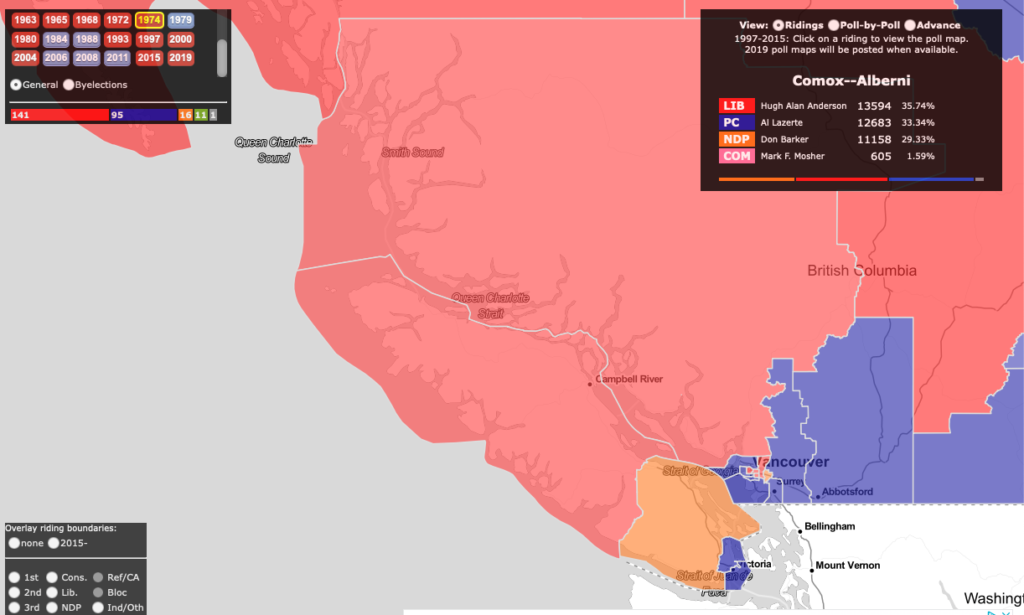
Hello Nanaimo
1979 was an important year for the riding as it split, with the northern portion again taking on many central coast areas in addition to Vancouver Island north of Cumberland, Courtenay, and Comox, and the south portion featuring the West Coast, Port Alberni and Nanaimo as the new Nanaimo-Alberni riding.
Ted Miller took the riding back for the NDP beating the Conservative candidate by 9% of the vote.
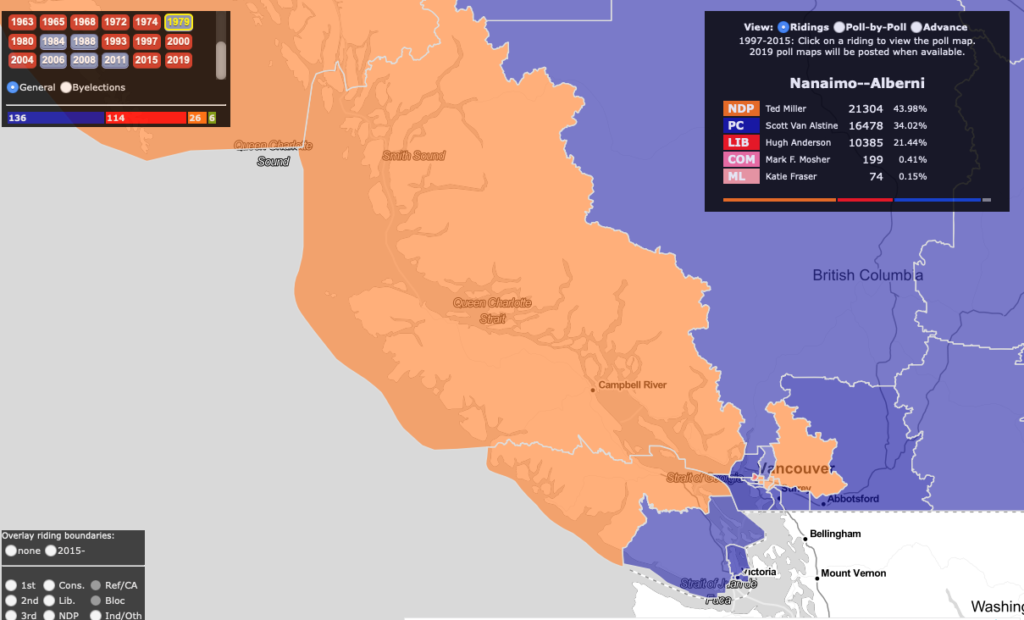
That was quickly followed by what was probably the most eclectic election in the riding’s history with Miller beating the PC candidate again but with representatives running for the Marxist-Leninist, Communist, and Frank Tee Pee Red Coffey warning over 1% of the vote for the Rhinocerous party!
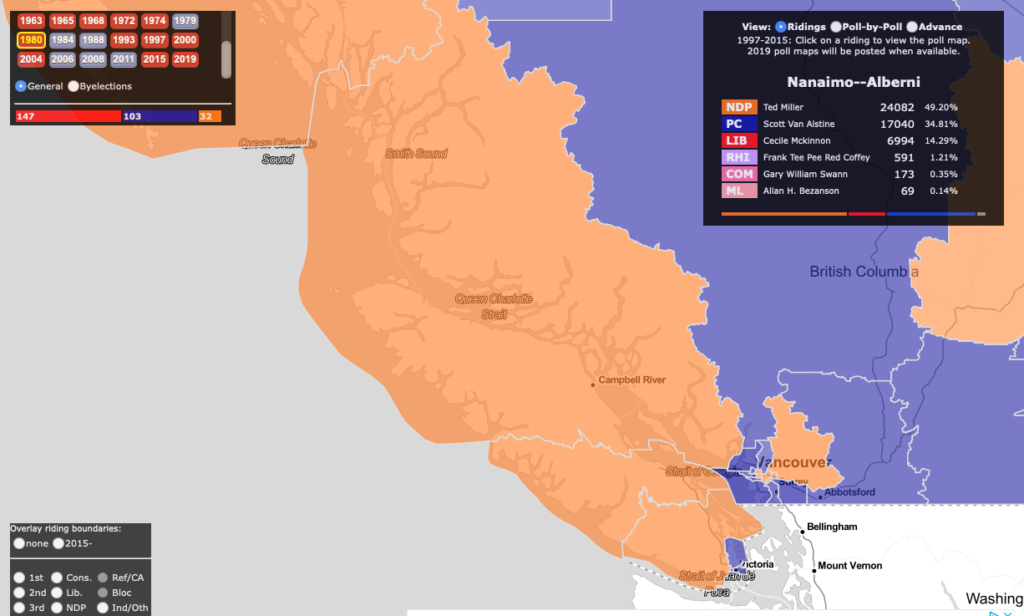
Green Blood
The 1984 election featured the first appearance of a Green Party candidate when Alleen Fletcher received 529 votes and 0.88%. The Conservative party narrowly beat the NDP with Ted Schellenberg as their candidate over Miller.
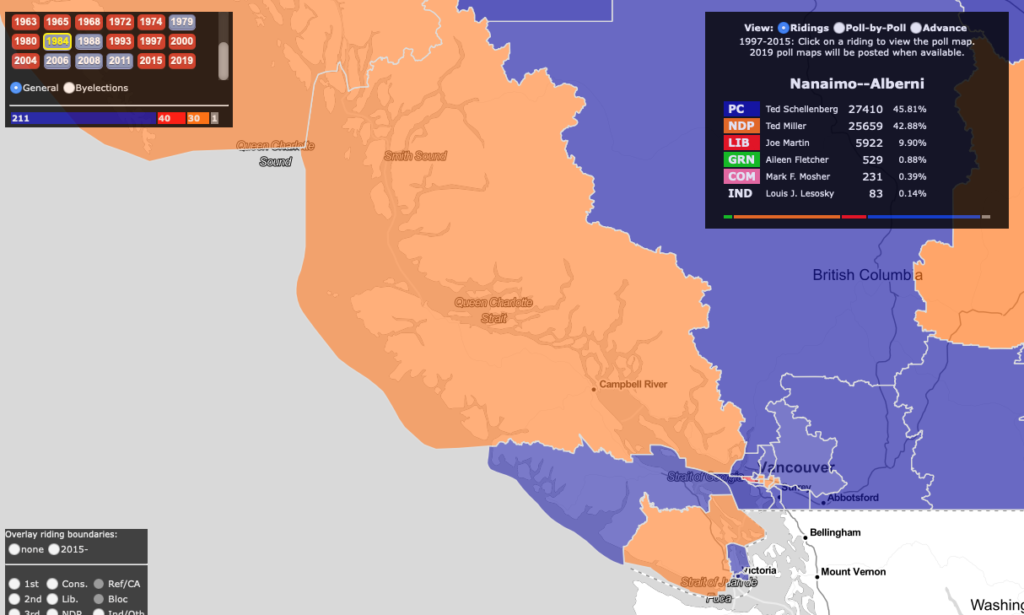
The 1988 election saw a plethora of candidates as the Reform party took hold and smaller parties such as the Christian Heritage Party started to appear. Robert Skelley won the riding back easily for the NDP.
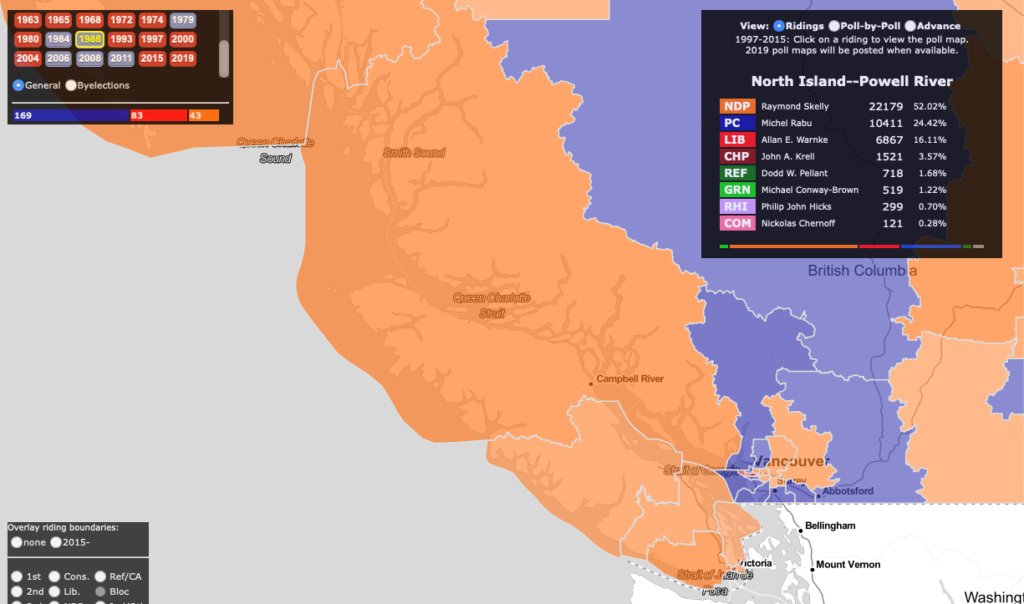
Conservative by any other name.
1993 saw the collapse of the Progressive Conservative party after Brian Mulroney’s disastrous government. This led to much of British Columbia joining the western Reform party. Ironically, the PC collapse ushered in a prolonged era of right-wing Conservative rule in the Alberni riding. Bill Gilmour won the riding over Hindle of the Liberals and Skelly of the NDP and a host of smaller parties.
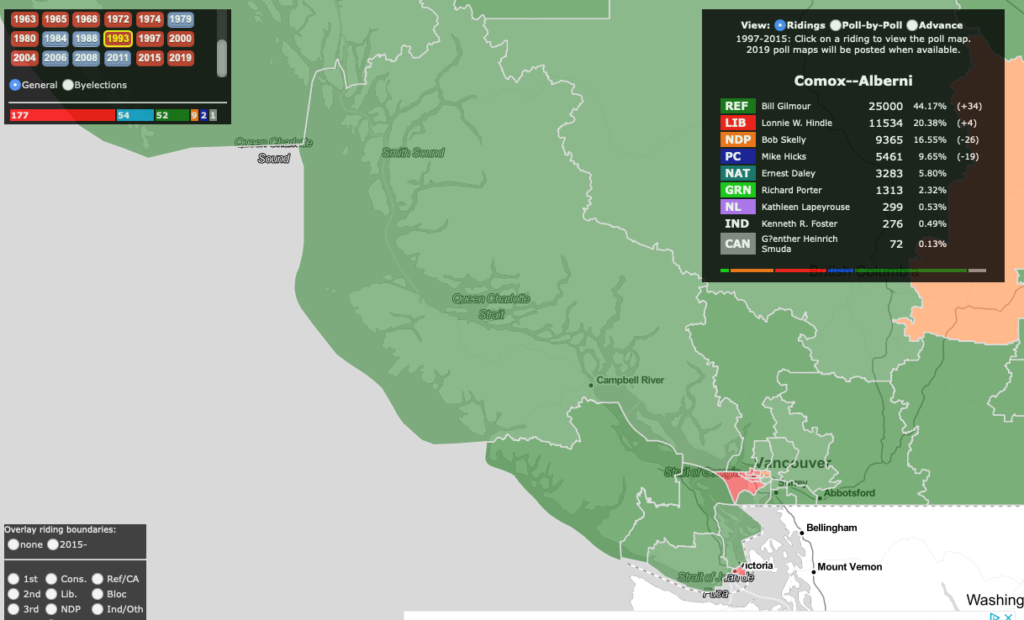
Gilmour held the riding until the Canadian Alliance took the Reform Party’s place in 2000 and James Lunney stepped in to represent the region as a CA and then Conservative Party of Canada backbencher for the following 15 years.
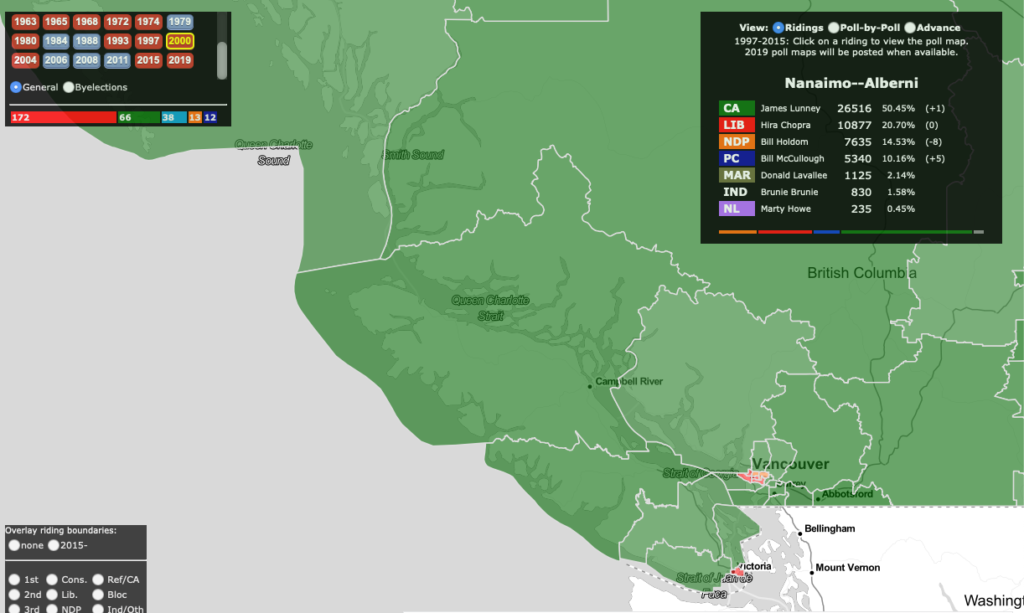
Reconnecting with Comox Valley roots.
In 2015, after 27 years since Bob Skelley last won, the NDP retook the riding with the election of Gord Johns.
The riding also reconfigured again, losing the southern Nanaimo portion and gaining a portion of the Courtenay and Cumberland area which may have had something to do with why it went back to the NDP in addition to the end of a long period of Conservative government federally.
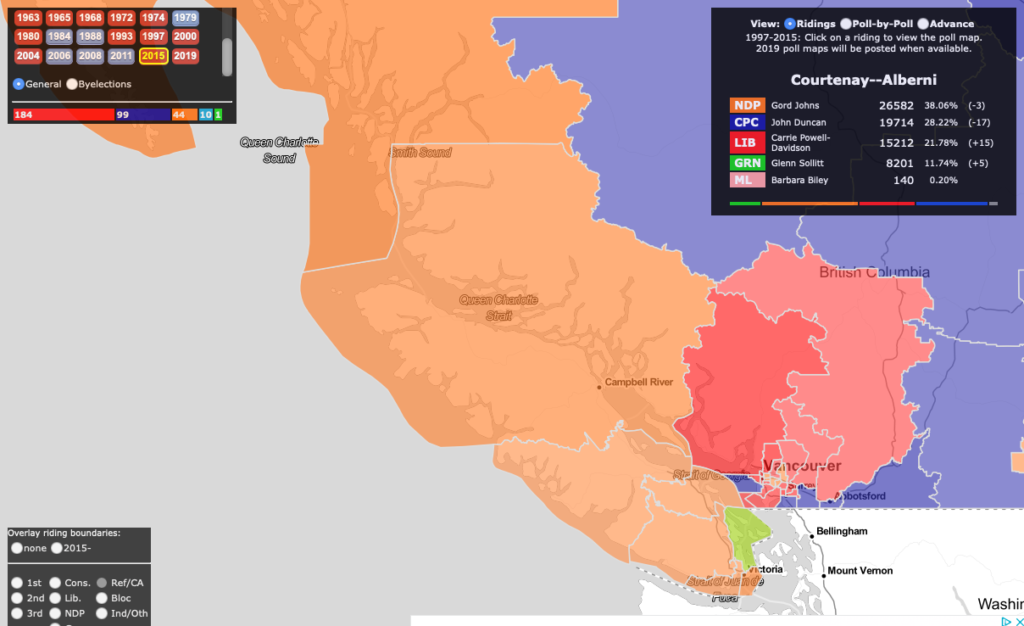
That’s it! That’s the entire history of the ridings that have included Port Alberni in the past 120+ years.
Maybe another day I’ll do the same for the provincial riding. 🙂
